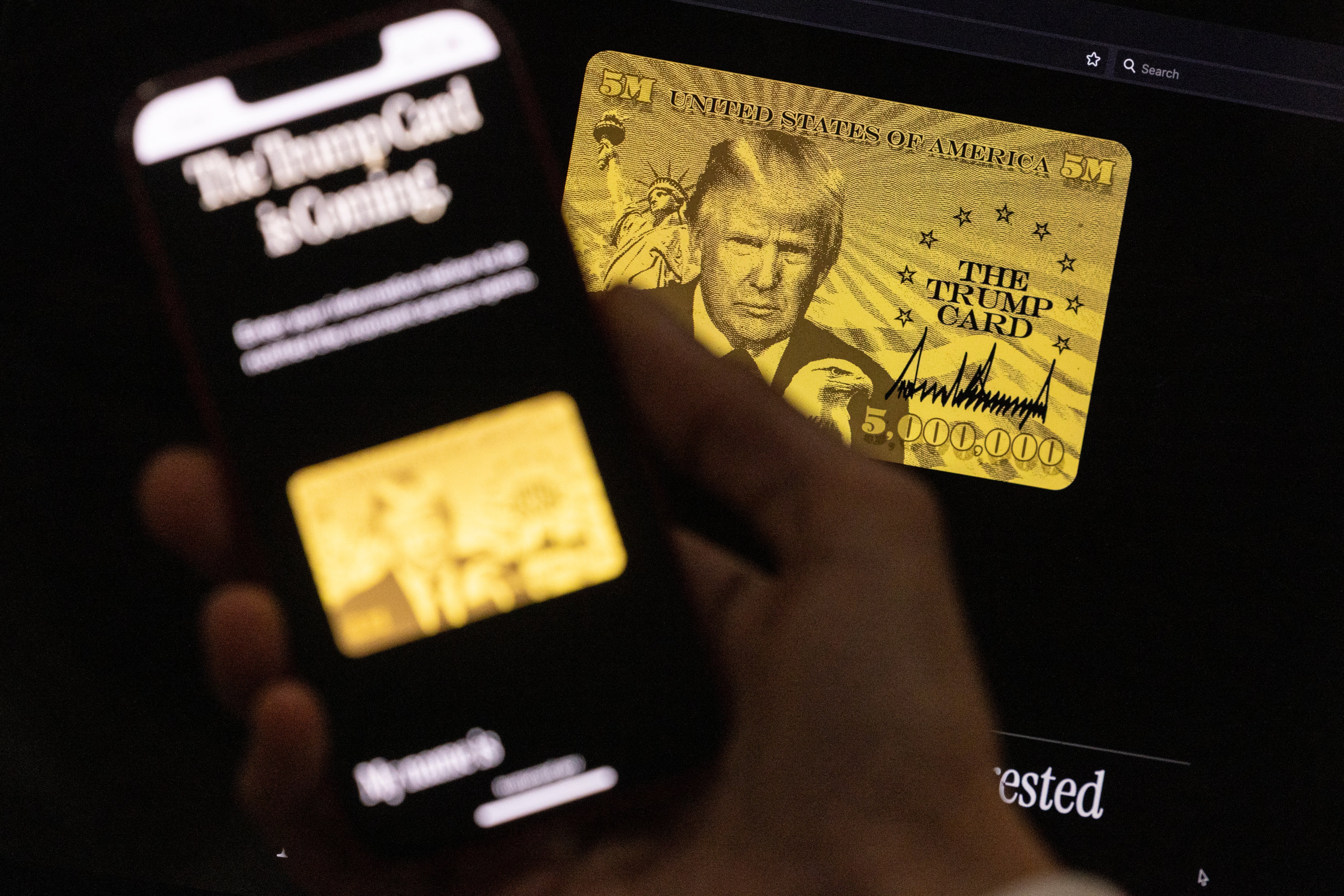Within the first few weeks of his presidency, Donald Trump had promised to open a fast lane for wealthy immigrants to obtain legal status in the United States for $5 million.
On April 3, he showed reporters a prototype for his Trump Card, which features the president’s face on a gold, laminated credit card that would act as a green card. The card was going to be ready “in about less than two weeks,” Trump said at the time. In June, the White House created a bare-bones website to sign up for information, promising that “The Trump Card is coming.”
Nearly one month later, it’s unclear what progress the administration is making. Republicans in Congress didn’t take the card into account with a recently passed megabill that overhauled immigration enforcement, nor did they even bring it up in a recent hearing on the future of visas. Legal experts are highly skeptical that the administration can pull it off at all.
The card would have to implement a new visa category, which the president cannot unilaterally create without legislation, raising even more constitutional questions about the president’s overreach with federal immigration law.
“There’s no lawful basis to do this, and if they do it anyway, they’re going to get sued, and they’re almost certainly going to lose,” Doug Rand, senior adviser to the former director of U.S. Citizenship and Immigration Services under President Joe Biden, told The Washington Post.
No administration has changed visa eligibility criteria since a 1990 law that forms the basis of current legal status categories, Rand said.
George Fishman, senior legal fellow at the Center for Immigration Studies and a deputy general counsel at the Department of Homeland Security during the first Trump administration, told The Post that he is “very dubious” that the White House can create a new visa pathway without an act of Congress.
In February, Treasury Secretary Howard Lutnick suggested the gold card would replace the EB-5 visa, which grants green cards to foreign nationals who invest at least $800,000 or $1.05 million in American businesses and create at least 10 jobs for American workers. The program raised $4 billion last year.
Lutnick said the program was “poorly overseen” and “poorly executed.”
“If we sell 200,000 of these gold green cards it is $1 trillion to pay down our debt, and that’s why the president’s doing it,” he told reporters in February.
But, unlike EB-5 visa holders, Trump card holders wouldn’t be liable for federal income tax on income earned outside the United States — raising yet another constitutional question over how the president can try to unilaterally change tax code.
“Issuing Trump’s gold cards is likely illegal, changing tax law is likely illegal, and ending the EB‑5 investor visa is likely illegal,” according to David J. Bier, director of immigration studies at the Cato Institute. “But even supposing that the president can get Congress to act, or can evade judicial review of his actions, few high value immigrants are going to hand over their fortunes to Trump.”
By June, more than 70,000 people had signed up to learn more about the card, Lutnick told the Financial Times. EB-5 visas, however, are limited to only 10,000 a year.
It’s unclear whether interest in the card will translate to actual applications. Many of the world’s millionaires already live in the United States. There are roughly 33.5 million people outside the country with at least $1 million, according to the UBS Global Wealth Report, but only about 1.5 million non-Americans with net assets above $5 million or more.
Political and financial instability and unrest will drive 142,000 millionaires out of their countries this year, according to an estimate from Henley & Partners, an immigration and financial investment consulting firm. The United Kingdom is expected to lose a net 16,500 millionaires, while the United Arab Emirates is estimated to add a net 9,800 and the United States is expected to gain 7,500.
A $5 million visa “to these people is jet fuel cost,” immigration lawyer Matthew Kolken told NPR earlier this year. He said the idea of simply purchasing a green card would allow the rich immigrants to “potentially buy their way into the United States” by merely putting it on a black American Express credit card, reserved for the wealthiest customers.
Immigration attorneys predict the highest demand would come from China and the Middle East, which combined have roughly 65,000 ultra-rich residents with net worths of $30 million or more, according to global wealth intelligence firm Altrata.

But the White House and Treasury Department have provided few details on eligibility criteria, the application process or how or why the Treasury Department would be involved.
“As a matter of law, it is important to remember that the president cannot unilaterally end or change the EB-5 program,” according to the American Immigration Lawyers Association.
That program was created by Congress in 1990 and codified in the Immigration and Nationality Act through the EB-5 Reform and Integrity Act of 2022
“Any attempt to eliminate or replace it requires legislative action,” the American Immigration Lawyers Association said.
That would likely open a lengthy and combative legislative process, with language to be debated and approved by both chambers of Congress. That would take “months, if not significantly longer,” according to the American Immigration Lawyers Association.
Trump’s “gold card” project has also been under the direction of Elon Musk’s so-called Department of Government Efficiency with controversial loyalists Marko Elez and Edward Coristine at the helm.
Elez had briefly resigned from the administration after The Wall Street Journal uncovered his now-deleted racist statements supporting “eugenic immigration policy” and calls to “normalize Indian hate,” among other posts on X. He was later granted access to the Social Security Administration, Customs and Border Protection, Immigration and Customs Enforcement and the Department of Homeland Security.
Coristine, known as “Big Balls,” also has had DOGE roles with the State Department and Homeland Security, among others. Last month, the 19-year-old programmer was hired by the Social Security Administration.
They have both met with various administration officials overseeing visa and immigration services over the last several months, according to The New York Times. By mid-April, they had asked the State Department to create a system that links gold visa applicants to Homeland Security, The Washington Post reported.
While the White House is looking to rewrite legal pathways into the United States, the administration has stripped legal status for more than 1 million people, including immigrants granted temporary humanitarian protections and international students.
The Department of Justice is also reviving attempts to revoke citizenship from naturalized American citizens and launching legal battles to defend Trump’s attempt to redefine birthright citizenship.







